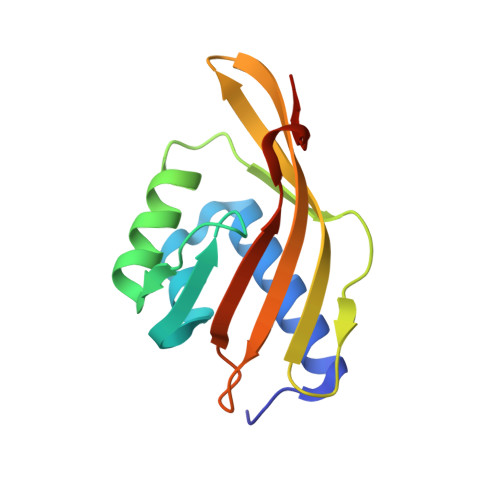Structural Coupling Throughout the Active Site Hydrogen Bond Networks of Ketosteroid Isomerase and Photoactive Yellow Protein.
Pinney, M.M., Natarajan, A., Yabukarski, F., Sanchez, D.M., Liu, F., Liang, R., Doukov, T., Schwans, J.P., Martinez, T.J., Herschlag, D.(2018) J Am Chem Soc 140: 9827-9843
- PubMed: 29990421
- DOI: https://doi.org/10.1021/jacs.8b01596
- Primary Citation of Related Structures:
6C17, 6C1J, 6C1X - PubMed Abstract:
Hydrogen bonds are fundamental to biological systems and are regularly found in networks implicated in folding, molecular recognition, catalysis, and allostery. Given their ubiquity, we asked the fundamental questions of whether, and to what extent, hydrogen bonds within networks are structurally coupled. To address these questions, we turned to three protein systems, two variants of ketosteroid isomerase and one of photoactive yellow protein. We perturbed their hydrogen bond networks via a combination of site-directed mutagenesis and unnatural amino acid substitution, and we used 1 H NMR and high-resolution X-ray crystallography to determine the effects of these perturbations on the lengths of the two oxyanion hole hydrogen bonds that are donated to negatively charged transition state analogs. Perturbations that lengthened or shortened one of the oxyanion hole hydrogen bonds had the opposite effect on the other. The oxyanion hole hydrogen bonds were also affected by distal hydrogen bonds in the network, with smaller perturbations for more remote hydrogen bonds. Across 19 measurements in three systems, the length change in one oxyanion hole hydrogen bond was propagated to the other, by a factor of -0.30 ± 0.03. This common effect suggests that hydrogen bond coupling is minimally influenced by the remaining protein scaffold. The observed coupling is reproduced by molecular mechanics and quantum mechanics/molecular mechanics (QM/MM) calculations for changes to a proximal oxyanion hole hydrogen bond. However, effects from distal hydrogen bonds are reproduced only by QM/MM, suggesting the importance of polarization in hydrogen bond coupling. These results deepen our understanding of hydrogen bonds and their networks, providing strong evidence for long-range coupling and for the extent of this coupling. We provide a broadly predictive quantitative relationship that can be applied to and can be further tested in new systems.
















